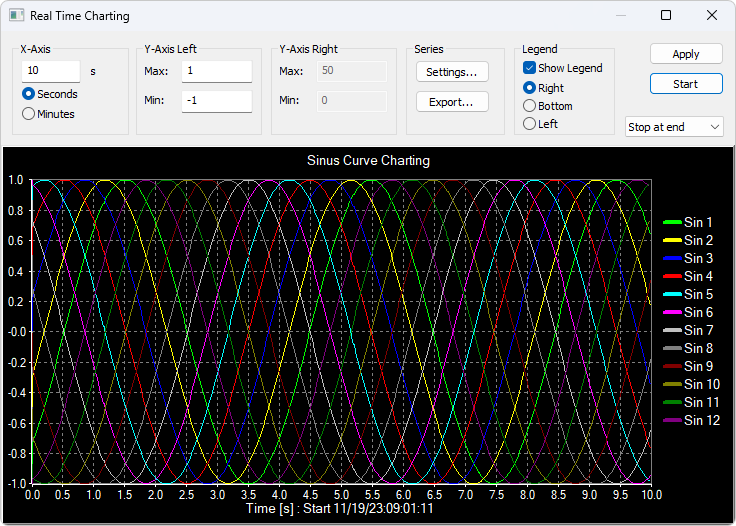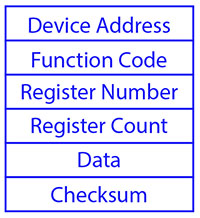
Modbus ASCII is an older implementation that contains all of the elements of an RTU packet, but expressed entirely in printable ASCII characters. Rather than defining master and slave on a physical device by device basis, it now becomes the system designer’s responsibility to create logical associations between master and slave functionality. In Modbus terms, this means there can be multiple masters as well as multiple slaves. There can be more than one client obtaining data from a server. In this context, the slave becomes the server and the master becomes the client. The definition of client and server are better known entities in Ethernet based networking. Modbus TCP makes the definition of master and slave less obvious because Ethernet allows peer to peer communication. Modbus TCP defines the presentation and application layers in the OSI model. The TCP version of Modbus follows the OSI Network Reference Model. Checksum and error handling are handled by Ethernet in the case of Modbus TCP. The checksum field normally found at the end of an RTU packet is omitted from the TCP packet. The standard port for Modbus TCP is 502, but port number can often be reassigned if desired. The address of most importance here is the IP address, e.g. The unit number is still included and its interpretation varies by application – the unit or slave address is not the primary means of addressing in TCP. Modbus TCP encapsulates Modbus RTU request and response data packets in a TCP packet transmitted over standard Ethernet networks.
#MODBUS POLL ILLEGAL DATA ADDRESS CODE#
The exception provides an error code that says "no such register" (exception code 2, illegal data address). If the register number does not exist in the slave device, it will send back an "oops" message properly known as an exception. Some devices might not have a register 1, and their first register may be number 100 for example. Most often, these start at 1 and count up sequentially. The "rows" in a Modbus device's "spread sheet" are simply the register number. Register type may be a coil, a discrete input (aka status input), an input register, or a holding register. The "columns" in a Modbus device's "spread sheet" are more formally known as register types. Of course, this process can be reversed with the Modbus master telling the slave what number to put into its data table at a given row and column.

The Modbus master will ask a slave for its data value or number found in a given row and column, and the slave will respond by sending that piece of data back to the master. Modbus slave devices can be visualized as having an internal spread sheet filled with numbers. Function code 16 is used to write one or more holding registers. Function code 6 is used to write a single holding register. The most common codes include 3 for "read holding registers", and may read 1 or more. The type of register being addressed by a Modbus request is determined by the function code. Coils are usually associated with relay outputs. Coils can be read or written, while discrete inputs are read-only. The exceptions to registers being 16 bits are the coil and the discrete input, which are each 1 bit only.

The other possible type is Input Register, which is read-only.

The most commonly used register is called a Holding Register, and these can be read or written. If a 32-bit integer or floating point is required, these values are actually read as a pair of registers. Most often, the register is either a signed or unsigned 16-bit integer. Modbus data is most often read and written as "registers" which are 16-bit pieces of data.

The majority of Modbus RTU devices only support speeds up to 38400 bits per second. Data is transmitted in 8-bit bytes, one bit at a time, at baud rates ranging from 1200 bits per second (baud) to 115200 bits per second.
#MODBUS POLL ILLEGAL DATA ADDRESS SERIAL#
Modbus RTU is a relatively simple serial protocol that can be transmitted via traditional UART technology. The most commonly used form of Modbus protocol is RTU over RS-485. A register address or register reference is always in the context of the slave’s registers. The master will write data to a slave device’s registers, and read data from a slave device’s registers. This means a slave device cannot volunteer information it must wait to be asked for it. Modbus protocol is defined as a master/slave protocol, meaning a device operating as a master will poll one or more devices operating as a slave. The Modbus protocol specification is openly published and use of the protocol is royalty-free. Modbus remains the most widely available protocol for connecting industrial devices. Modbus is an industrial protocol standard that was created by Modicon, now Schneider Electric, in the late 1970’s for communication among programmable logic controllers (PLCs).


 0 kommentar(er)
0 kommentar(er)
